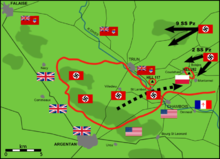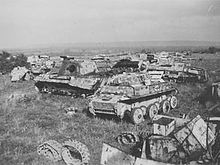Hill 262
| Battle of Hill 262 | |||||||
|---|---|---|---|---|---|---|---|
| Part of Operation Tractable, Operation Overlord | |||||||
 Polish Infantry moving towards cover on Mount Ormel, 20 August 1944. | |||||||
| |||||||
| Belligerents | |||||||
|
|
| ||||||
| Commanders and leaders | |||||||
|
|
| ||||||
| Strength | |||||||
| 2 Armoured Battlegroups[3] | remnant units of several Panzer divisions[nb 1] | ||||||
| Casualties and losses | |||||||
| 1,441 [nb 2] — 5,132 casualties[nb 3] | ~2,000 killed[nb 4] | ||||||
Hill 262 or Mont Ormel in Normandy (elevation 262 m), also known as The Mace,[nb 5] was the location of vital command posts for both Allied and German forces during World War II. The position provided an excellent view of the area around Chambois and Vimoutiers. After Operation Cobra, Hill 262 was a key position involved in the entrapment of the remaining German forces in Normandy and the closure of the Falaise pocket in August 1944. Previously held by the Germans, the hill was captured by battlegroups of Stanisław Maczek's Polish 1st Armoured Division on 19 August 1944.
German Generalfeldmarschall Walter Model was aware of the need to keep the pocket open to allow Seventh Army troops to escape encirclement. On the morning of 20 August, he ordered elements of two panzer divisions to attack Polish positions on Hill 262. Despite stiffening Polish resistance and well coordinated artillery barrages, the Germans managed to gain terrain and hold an open corridor, allowing some troops to escape. Throughout 20 August, fierce German attacks inflicted heavy losses on the entrenched Polish forces, who became exhausted and ran out of ammunition, but did not surrender the hill. On 21 August, less intense German attacks continued until noon, when Polish troops defeated the last SS remnants capable of battle. Because of the successful Polish defense of Hill 262, by the evening of 21 August the Falaise pocket was completely closed, and all German forces within it were either dead or in captivity.
Background
Following the failed German counter-attacks succeeding Operation Cobra, the successful American breakout offensive from the Normandy beachead in July 1944, the town of Falaise became a major Allied objective, as its capture would cut off virtually all of Generalfeldmarschall Günther von Kluge's Army Group B.[7] To capture Falaise, General Harry Crerar, commanding the newly inaugurated First Canadian Army, and Lieutenant-General Guy Simonds of II Canadian Corps, planned an Anglo-Canadian offensive code-named Operation Totalize.[8] Despite initial gains on Verrières Ridge and near Cintheaux, the offensive stalled on 9 August, due to strong German counterattacks as well as poor Canadian unit leadership and fighting power,[9] resulting in heavy casualties for the 4th Canadian and 1st Polish Armoured Divisions.[10] By 10 August, Anglo-Canadian forces had reached Hill 195, north of Falaise; however, they had been unable to capture the town itself.[10]
On 14 August, Canadian forces started Operation Tractable, a major offensive towards Falaise, and managed to capture the town on 17 August.[11] Hill 262, located east of the town, became a crucial position for closing the Falaise Pocket, as it would prevent German forces from relieving the German Seventh Army trapped in the pocket.[12]
Meanwhile, the Polish 1st Armoured Division split into four battlegroups, allowing for the rapid clearing of objectives and defenses north of Chambois. On 19 August, two of these battlegroups moved against Hill 262, while the other two moved to link up with American forces in Chambois.[13]
Battle
By the afternoon of 19 August, the two Polish battlegroups annihilated a German infantry company and secured Hill 262.[14] Meanwhile, the 4th Canadian Armoured Division, which captured Trun and Champeaux a day earlier, reinforced Polish forces and managed to secure Chambois by the evening.[15] Throughout the night of 19 August, Polish forces entrenched themselves along the south, southwest, and northeastern lines of approach to Hill 262.[16] Meanwhile, Field Marshal Model was aware of the need to keep the pocket open, and on the morning of 20 August ordered elements of the 2nd and 9th SS Panzer Divisions to attack Polish positions on Hill 262 from the east[13] in order to allow the retreat of the Seventh Army.[15] Directly southwest of Mont Ormel, German units moved along what would later become known as "The Corridor of Death", as the Polish inflicted heavy casualties on German forces moving towards Mont Ormel with a well-coordinated artillery barrage.[3] At approximately noon, however, several units of the 10th SS, 12th SS, and 116th Panzer Divisions managed to break through the weakened Polish positions. At the same time, the 9th SS Panzer Division was preventing Canadian troops from reinforcing Polish forces.[3] As a result, by mid afternoon, about 10,000 German troops managed to escape through the corridor.[17]

In the meantime, the 3rd Parachute Division, along with an armoured regiment of the 1st SS Panzer Division, attacked Mont Ormel from inside the Falaise Pocket. The attack was repulsed by Polish artillery, which "massacred" German infantry and armour closing in on their positions.[17] Despite being overwhelmed at some locations on the hill, Polish forces continued to hold the high ground on Mont Ormel, exacting a deadly toll on passing German forces through the use of well-coordinated artillery fire.[18] Irritated by the presence of these units, which were exacting heavy casualties on his men, Oberstgruppenführer Paul Hausser—commanding the Seventh Army—ordered the positions to be "eliminated".[17] Although substantial forces, including the 352nd Infantry Division and several battle groups from the 2nd SS Panzer Division, inflicted heavy casualties on the 8th and 9th Battalions of the Polish 1st Armoured Division, the German attack was ultimately fought off. Nevertheless, the Poles exhausted almost all of their ammunition in the battle, leaving them in a precarious position.[18] Soon, the exhausted Polish troops, with ammunition supplies at extremely low levels, were forced to watch as the remnants of the XLVII Panzer Corps escaped the pocket. After the brutality of the combat that had occurred during the day, both German and Polish forces surrounding Mont Ormel welcomed the night. Fighting was sporadic, as both sides avoided contact with one another. Frequent Polish artillery strikes interrupted German attempts to retreat from the sector.[18] Antoni Stefanowicz, commander of the Polish battlegroups on Hill 262, was very skeptical of his force's chance of survival and stated:
Gentlemen. Everything is lost. I do not believe [the] Canadians will manage to help us. We have only 110 men left, with 50 rounds per gun and 5 rounds per tank… Fight to the end! To surrender to the SS is senseless, you know it well. Gentlemen! Good luck – tonight, we will die for Poland and civilization. We will fight to the last platoon, to the last tank, then to the last man.[19]
German attacks on the hill resumed resumed the morning of 21 August. Although not as coordinated as on the day before,[20] the attack still managed to reach the last of the Polish defenders on Mont Ormel. As the remaining Polish forces barely repelled the assault, their tanks were forced to use the last of their ammunition.[20] At approximately 12:00, the last SS remnants launched a final assault on the positions of the 9th Battalion, but were defeated at point-blank range. There would be no further attacks; the two battlegroups of the Polish 1st Armoured Division had survived the onslaught, despite being completely surrounded by German forces for three days. Within an hour, The Canadian Grenadier Guards managed to link up with what remained of Stefanowicz's men.[21]
Aftermath

By evening of 21 August, due to the Polish victory at Hill 262, the Falaise pocket could properly be considered closed.[22] Tanks of the Canadian 4th Armoured Division linked with Polish forces at Coudehard, while the Canadian 3rd and 4th Infantry Divisions secured St. Lambert and the northern passage to Chambois.[22]
The battle for Hill 262 according to one report had cost the Polish 1st Armored Division severely: 325 killed, 1,002 wounded, and 114 missing, approximately 20% of the division's remaining fighting strength.[5] However, another report counts that the battle had cost the Polish 1st Armored Division 1,290 troops killed, 3,820 wounded and 22 missing in action.[6] Although perhaps 100,000 German troops succeeded in escaping the Allies because of the delay in closing the gap (many of them wounded), they left behind 40,000-50,000 prisoners and over 10,000 dead.[1] According to military historian Gregor Dallas: "The Poles had closed the Falaise Pocket. The Poles had opened the gate to Paris."[23] On the 20th anniversary of Falaise, former President Dwight D. Eisenhower, commented: "No other battlefield presented such a horrible sight of death, hell, and total destruction."[6]
Notes
- Footnotes
- ^ Units involved in counterattacks on Mont Ormel were the 2nd SS, 9th SS, 10th SS, 12th SS, and 116th Panzer Divisions.[4]
- ^ 325 killed, 1,002 wounded, and 114 missing [5]
- ^ 1,290 troops killed, 3,820 wounded and 22 missing in action.[6]
- ^ An additional 5,000 were taken prisoner, including a general, six colonels and 80 officers. The Germans left on the battlefield 55 tanks, of which 14 were Panthers and 6 Tigers, 44 guns and 152 armoured vehicles, 359 vehicles of all types were destroyed.[5]
- ^ In Polish Maczuga, because the ridge on this hill resembled a caveman's mace with two bulbous heads
- Citations
- ^ a b Williams, p. 204
- ^ Hastings, p. 306
- ^ a b c Jarymowycz, p. 196
- ^ Hastings, p. 303
- ^ a b c Dillon, Jim (March 22, 2004). "A Polish Battle, Normandy 1944". BBC. Retrieved June 18, 2008.
- ^ a b c Guttman, Jon (2001). "World War II: Closing the Falaise Pocket". World War II magazine. Retrieved June 18, 2008.
{{cite web}}: Unknown parameter|month=ignored (help) - ^ D'Este, p. 404
- ^ Hastings, p. 296
- ^ Hastings, p. 301
- ^ a b Bercuson, p. 230
- ^ Copp, p. 104
- ^ Bercuson, p. 230
- ^ a b Jarymowycz, p. 195 Cite error: The named reference "Jarymowycz195" was defined multiple times with different content (see the help page).
- ^ "Closing the Falaise Gap". Memorial Mont-Ormel. Retrieved February 16, 2009.
- ^ a b Hastings, p. 304
- ^ D'Este, p. 456
- ^ a b c Van Der Vat, p. 168 Cite error: The named reference "Van-Der-Vat 168" was defined multiple times with different content (see the help page).
- ^ a b c D'Este, p. 458
- ^ Jarymowycz, p. 201
- ^ a b "The End of the German 7th Army". Memorial Mont-Ormel. Retrieved June 13, 2008.
- ^ Bercuson, p. 232
- ^ a b Hastings, p. 313
- ^ Dallas, p. 160
References
- Bercuson, David (2004). Maple Leaf Against the Axis. Red Deer Press. ISBN 0-88995-305-8.
{{cite book}}: Cite has empty unknown parameter:|coauthors=(help); Unknown parameter|origdate=ignored (|orig-date=suggested) (help) - Copp, Terry (2006). Cinderella Army: The Canadians in Northwest Europe, 1944-1945. University of Toronto Press. ISBN 0802039251.
- Dallas, Gregor (2005). 1945: The War That Never Ended. Yale University Press. ISBN 0-30010-980-6.
- D'Este, Carlo (1983). Decision in Normandy. Konecky & Konecky. ISBN 1-56852-260-6.
- Hastings, Max (2006). Overlord: D-Day and the Battle for Normandy. Vintage Books USA; Reprint edition. ISBN 0-30727-571-X.
{{cite book}}: Cite has empty unknown parameter:|coauthors=(help); Unknown parameter|origdate=ignored (|orig-date=suggested) (help) - Jarymowycz, Roman (2001). Tank Tactics; from Normandy to Lorraine. Lynne Rienner. ISBN 1555879500.
- McGilvray, E. (2005). The Black Devil's March - A Doomed Odyssey: The 1st Polish Armoured Division 1939-1945. Helion & Company Ltd. ISBN 1-87462-242-6.
